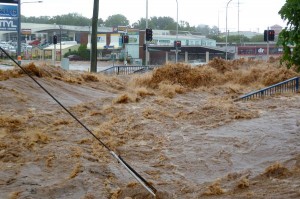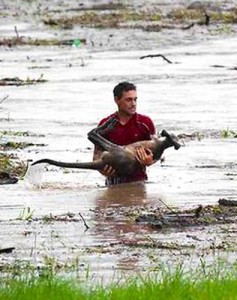Today we remember the devastating Floods of January 2011.
 January 10th 2011, we watched in disbelief as the horror of Toowoomba, then the Lockyer Valley unfolded. The good in people shone through and in the words of Breanda Cross, ‘…in the days and weeks to follow, friendships were made, reputations were gained, gratitude was given, and stories filtered through of heroics and selflessness. Excuses of being too old, or incapable, began to crumble, as extraordinary stories began to surface of the ways people, young and old, undertook novel ways to raise money ‘to do their bit,’ to help…’
January 10th 2011, we watched in disbelief as the horror of Toowoomba, then the Lockyer Valley unfolded. The good in people shone through and in the words of Breanda Cross, ‘…in the days and weeks to follow, friendships were made, reputations were gained, gratitude was given, and stories filtered through of heroics and selflessness. Excuses of being too old, or incapable, began to crumble, as extraordinary stories began to surface of the ways people, young and old, undertook novel ways to raise money ‘to do their bit,’ to help…’
On this first anniversary, our thoughts and prayers are still with everyone, so many were and still remain, affected by these floods in one way or another.
Toowoomba and the Lockyer Valley – From Wikipedia, the free encyclopaedia www.en.wikipedia.com
The city of Toowoomba, in the Darling Downs, was hit by flash flooding after more than 160 millimetres (6.3 in) of rain fell in 36 hours to 10 January 2011; this event caused four deaths in a matter of hours. Cars were washed away. Toowoomba sits on the watershed of the Great Dividing Range, some 700 metres (2,300 ft) above sea level. A three week period where it had rained on all but three days had left the soil around Toowoomba super saturated and when a line of storms hit the city on 10 January, the resulting torrential rain rapidly ran off down gullies and streets. The central business district of the city sits in a small valley where two small water courses—East Creek and West Creek—meet to form Gowrie Creek. Unable to cope with the volume of water heading toward them, the creeks burst their banks, pushing a devastating wall of water through the city centre. This water then headed west, not towards the Lockyer Valley which was also experiencing extreme rainfall that fell on eastern facing slopes.
The surge passed through the Lockyer Valley town of Withcott, where the force of the water pushed cars into shops and forced the evacuation of hundreds of people. The scene was described by an onlooker as “like Cyclone Tracy has gone through it … If you dropped an atom bomb on it, you couldn’t tell the difference.” Nearby Helidon had several homes and farms flooded but did not break the main creek bank and enter the town. It was cut off from all sides by destroyed roads. Grantham was also devastated by the surge of water. Houses were left crumpled by what Premier of Queensland Anna Bligh described as an “inland tsunami”. According to local media, the flood waters had reached a height of 7 or 8 m (23 or 26 ft) by the time it struck Grantham. At least 100 people were evacuated to the Helidon Community Hall. Nine people were confirmed dead, and many more feared dead among 66 reported missing. The body of one victim washed away at Grantham was recovered 80 kilometres (50 mi) downstream and Queensland Police Commissioner Bob Atkinson warned that some bodies may never be found. Nearby Gatton saw voluntary evacuations as the Lockyer Creek rose to a record height of 18.92 metres (62.1 ft), exceeding the previous record set in the 1893 Queensland floods.
Raymond rescued the joey about 100 meters down the road from his home in Ipswich.

Leave a Reply